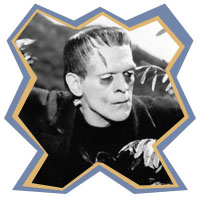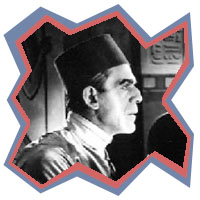
Hollywood's most successful boogeyman, a gaunt, bow legged actor whose menacing mien scared the bejesus out of several generations of film fans, was in fact one of the movie colony's most popular citizens, and by all accounts a gentle, sensitive, highly cultured man. The scion of a family of British diplomats, he eschewed foreign-service work in favor of acting, emigrating to Canada and eventually touring with small companies all over North America. He made his screen debut as an extra in
The Dumb Girl Of Portici (1916), but didn't approach film work in earnest until 1919, when he appeared in the Douglas Fairbanks starrer
His Majesty, The American.
By now billed as Boris Karloff, he played supporting roles-mostly heavies- in dozens of minor features and serials throughout the 1920s, including
The Hope Diamond Mystery (1921),
Nan Of The North (1922),
Dynamite Dan (1924),
Lady Robin Hood (1925),
Eagle Of The Sea (1926),
Tarzan And The Golden Lion (1927),
King Of The Kongo (1929), and
The Fatal Warning (1929). He appeared in a few movies, too, including
Old Ironsides (1926) and
Two Arabian Knights (1927). Although Karloff spoke in soft, cultured tones, he affected a harsh, guttural voice in his early sound films, which included
The Unholy Night (1929),
The Sea Bat (1930),
Public Defender,
Smart Money (1931),
Business And Pleasure (1931), and
The Mad Genius (1931).

Karloff spent the next several years alternating horror films with more prestigious major-studio productions. He scared moviegoers witless with his starring turns in
The Old Dark House (1932),
The Mummy (1932),
The Mask Of Fu Manchu (1932),
The Ghoul (1933),
Bride Of Frankenstein (1935),
The Black Room (1935), and
The Walking Dead (1936), in addition to three films that teamed him with his partner-in-menace Lugosi:
The Black Cat (1934),
The Raven (1935), and
The Invisible Ray (1936). He also took colorful supporting roles, playing a sleazy reporter in
Five Star Final (1931), a gangster in
Scarface (1932), an anti-Semitic nobleman in
House Of Rothschild (1934), a religious fanatic in
The Lost Patrol (1934), a kindly inventor in
Night Key (1937), and a suspicious opera singer in
Charlie Chan At The Opera (1937).
As the horror cycle waned in the late 1930's, Karloff found himself mired in undistinguished B-films, including
West Of Shanghai (1937),
The Invisible Menace (1938), and
British Intelligence (1940). He starred as a low-rent Charlie Chan in several
Mr. Wong mysteries for Monogram, the best of which was
The Mystery Of Mr. Wong (1939). Back at Universal, he played the Frankenstein monster for a third and final time in
Son of Frankenstein (1939) and then supported Basil Rathbone in an elaborate costume drama with horrific overtones,
Tower Of London (also 1939).
By now typecast as a movie menace, Karloff worked during the 1940's almost exclusively in B-horror films and thrillers, including
The Man With Nine Lives (1939),
Before I Hang (1940),
You'll Find Out (a horror spoof that teamed him with Bela Lugosi and Peter Lorre) (1940),
The Ape (1940),
The Devil Commands (1941),
The Boogie Man Will Get You (1942),
The Climax (a cut above his usual 1940s' vehicles) (1944),
House Of Frankenstein (this time as mad scientist rather than monster) (1944), and
Dick Tracy Meets Gruesome (1947). The "murder man" (as he was sometimes billed) spoofed his screen persona in the 1941 stage production of
Arsenic And Old Lace, enjoying a lengthy Broadway run as that play's menacing madman (but, unfortunately, missing out on repeating the role in the movie). He was well served by RKO producer Val Lewton, whose stylish, low-budget chillers ranked head and shoulders above the usual run of horror films; his assignments in Lewton's
The Body Snatcher (1945, which again teamed him with Lugosi),
Isle Of The Dead (also 1945), and
Bedlam (1946) were among his most memorable of the decade.
Karloff got a few nice supporting roles in A-films of the immediate post-WWII era, including
The Secret Life Of Walter Mitty (1947),
Unconquered (1948, as an Indian), and
Tap Roots, (1949), but by the 1950's he was working almost exclusively in dreary, low-budget horrors (in both senses of that word) that traded on the success of his earlier films:
Abbott And Costello Meet the Killer, Boris Karloff (1949),
The Strange Door (1951),
The Black Castle (1952),
Abbott And Costello Meet Dr. Jekyll And Mr. Hyde (1953),
Voodoo Island (1957),
The Haunted Strangler (1958), and
Frankenstein 1970 (1958) saw an aging Karloff going through the motions with obvious professionalism but little enthusiasm.
He fared better on Broadway during the 1950's, playing Captain Hook opposite Jean Arthur as Peter Pan, costarring with Julie Harris in
The Lark, and participating in a number of live TV plays as well. He starred in the filmed TV series
Colonel March Of Scotland Yard (1957-58), and hosted
Thriller (1960-62) in addition to guesting in dozens of dramatic series, anthologies, sitcoms, and variety shows throughout the 1950s and










